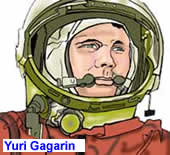
Dimdima
Online Children's Magazine from India

Dimdima
Online Children's Magazine from India
First Man In Space

While the United States conducted its space programme in the full glare of international publicity, the Soviet Union adopted a policy of secrecy.
Alan Shepherd had been selected by NASA to be the first of the ‘Mercury Seven’ to travel in space and Shepherd himself wholly expected to become the world’s first spaceman. But three days after the ‘Mercury Seven’ had been introduced to the American public, Shepherd was woken up in the middle of the night by a phone call from a NASA official.
“They’ve done it,” gasped the official. “The Russians have put a man into orbit!”
It was 12 April, 1961.
The man who had been put into orbit was 27-year-old Yuri Gagarin, a Soviet air force pilot. He was rocketed into orbit in the spacecraft Vostok-1 from Baikonur Cosmodrome in Kazakhstan. Vostok which means “East’ in Russian, was a sphere 2.3 metres in diameter. The cosmonaut sat in an ejector seat, which he could use to parachute to safety in the event of an emergency during the launch. Gagarin had no control of the craft during the mission. The effect of weightlessness had been tested only on dogs and Soviet scientists did not know how weightlessness would affect a man. They did not want to take any chances so Vostok was controlled entirely from the ground. A key was available in a sealed envelope in case it became necessary for Gagarin to take over controls in an emergency. Gagarin however performed many functions like eating, drinking, and writing while in orbit, and showed that the state of weightlessness was neither life threatening nor incapacitating.
 Yuri Gagarin made just one orbit of Earth, and his entire flight from lift-off to touchdown lasted 108 minutes, but it created a sensation as great as the launch of the first artificial satellite, Sputnik, in 1957.
Yuri Gagarin made just one orbit of Earth, and his entire flight from lift-off to touchdown lasted 108 minutes, but it created a sensation as great as the launch of the first artificial satellite, Sputnik, in 1957.
EXPLORE MORE...
Get Help or Give Help.
- Do you have a Science Question?
- Post it here and get the answer.
- Some questions posted by others are not yet answered.
- View those questions and answer them.
Dimdima is the Sanskrit word for ‘drumbeat’. In olden days, victory in battle was heralded by the beat of drums or any important news to be conveyed to the people used to be accompanied with drumbeats.
Bharatiya Vidya Bhavan
K. M Munshi Marg,
Chowpatty, Mumbai - 400 007
email : editor@dimdima.com
Bharatiya Vidya Bhavan
505, Sane Guruji Marg,
Tardeo, Mumbai - 400 034
email : promo@dimdima.com
Dimdima.com, the Children's Website of Bharatiya Vidya Bhavan launched in 2000 and came out with a Printed version of Dimdima Magazine in 2004. At present the Printed Version have more than 35,000 subscribers from India and Abroad.